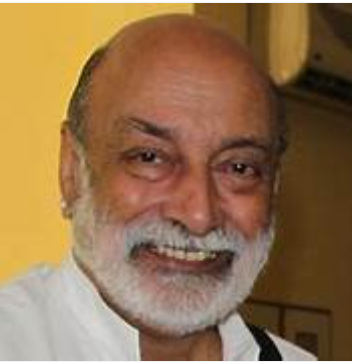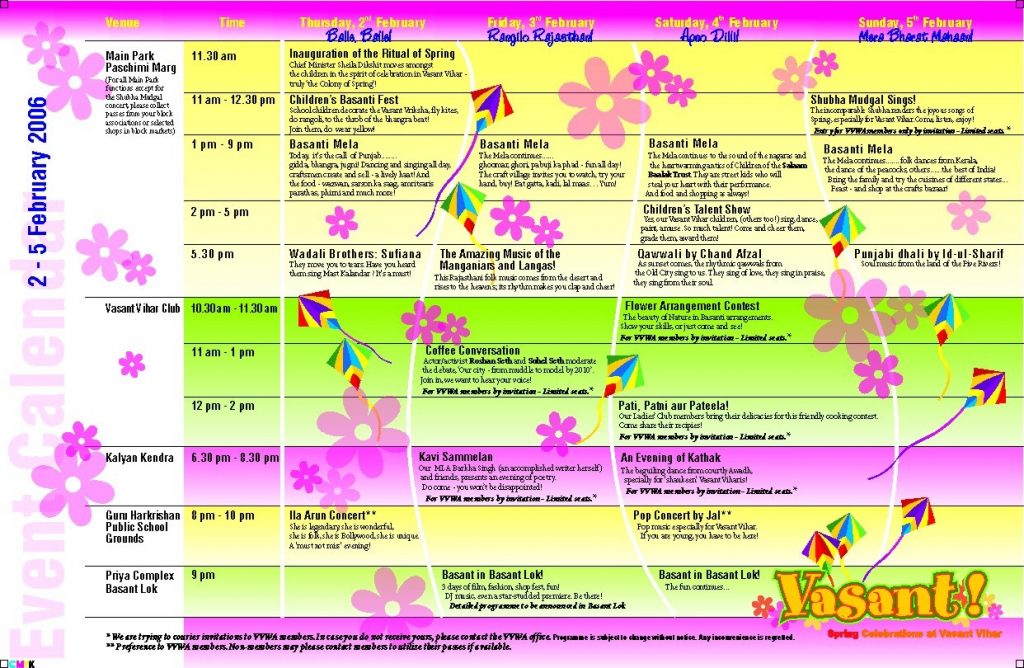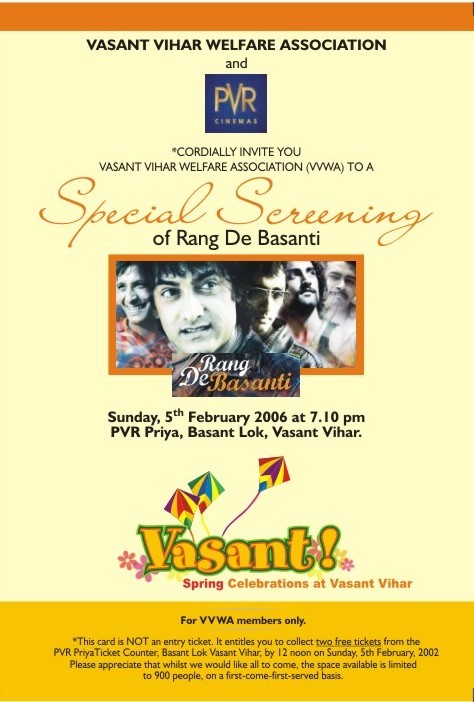
I have been a resident of Vasant Vihar since 1971, living in our lovely house built by my father way back in 1967. Given our long association with VV and my experience of working with government and political leaders, some senior residents of the colony asked me to get involved in helping the community. I decided to give back to the community by becoming a functionary in the Vasant Vihar Welfare Association, and in 2006 I was elected President of VVWA. Soon I got immersed in galvanising efforts to improve our locality.
Our first step was to improve the facilities available for functioning of the VVWA, which were then very meagre. We got furniture, including the long meeting table used even today, carpet, basic IT infrastructure, lights etc., all of which were either contributed by external donors, or mobilised from our homes. Soon after, we had meetings with each of the blocks to identify their problem areas, and small committees were created of active residents, for targeting various issues like water, horticulture etc. Based on inputs received from these consultations, I approached government authorities and political leaders, including Mrs.Sheila Dixit, who was then CM of Delhi, to get their support for addressing the problems faced in VV. Regular meetings were also held with the various committee in-charges to track progress on their work areas. In fact, for the first time VVWA did a formal presentation at the General Body Meeting, which was made by Veena Bhatnagar, then Secretary VVWA. At the GBM, I also insisted that the VVWA Committee sat on the same level as the residents, and not on the stage. Earlier the VVWA had tended to be characterised by groupings and cliques based on community lines, cadre affiliation etc. I tried to get past these and involve everyone in working for the community. This was how we slowly established a way of working that was based on greater community involvement.
It was during this period that I happened to have a conversation with the then French Ambassador’s wife Marie-Laure de Villepin, whom I used to occasionally meet at the Embassy. She was a frequent visitor to Vasant Vihar as her daughter was studying in a play school here and was quite fond of the colony. During that conversation she asked me, why don’t you have a cultural festival in VV, involving music, dance and literature. The thought stayed with me. The VV Club wasn’t organising such events at that time, and there was a need to have an event that could galvanise the community, beyond the usual humdrum matters of bijli, paani and naala (sanitation), which had been the primary focus of all our efforts till then.
I decided to take the idea forward and sought a meeting with Mrs.Sheila Dixit, the CM of Delhi, to elicit her support. To my utter surprise, when I mooted the idea of a festival in our colony, she readily agreed to not only support the festival, but to also come for the event. I thought it was a flip remark, but she asked for dates and then she actually turned up for the event. But that came later…
Once we had the CM’s endorsement and support, we got the Sahitya Kala Parishad (SKP) involved, and the rest of it moved quite quickly. Apart from the VVWA functionaries like Veena Bhatnagar, Lalita Phadkar, we also brought in a group of young residents who worked closely with the VVWA for planning and coordinating all arrangements. Vivek Kumar, Harish Doraiswamy, Sanjana Raj were among those who were actively involved.
Being very familiar with the world of art and culture, I could readily reach out to several leading artists/ designers. SKP also galvanized many artists. Shubha Mudgal, Shobha Deepak Singh, Raghuvendra Rathore were all known to me, and readily agreed to be a part of the event. In addition, the Wadali Brothers, Ila Arun, the Manganiars and Langars were onboarded. Suhel Seth who was then advising Sheila Dixit, looped in Marut Sikka the well-known chef and restaurateur, who added zest and masala by providing free gourmet food through the duration of the event.
It was decided that the festival would be called “Vasant Utsav” after the locality’s name, and themed on the colours and mood of spring. It was planned over a period of four days from 2nd to 5th of February, 2006.
On the morning of the inauguration, we were busy with the arrangements and before we knew it Sheila Dixit arrived, dot on time. She said “Aapne bulaaya toh mein aa gayi”. It was the time of the patang utsav (kite festival) with children making kites and flying them. Later there was a bhangra performance by school children from Guru Harkishan Public School. Sheila Dixit joined the children on stage and encouraged them along in a spirit of informal enjoyment and laughter. Children from Salaam Baalak Trust also joined in for the inauguration.
The park next to the VV Club was christened Vasant Utsav Park. Several ambassador wives, led by the French Ambassador’s wife were there. Later there was a walk down Paschimi Marg in which the residents joined in, and Sheila Dixit also walked along for some distance.

Drawing on my past experience of organising large cultural events, I was personally overseeing the sound/ stage arrangements for the artists since many were renowned national names in their field. We had to ensure that the performances did justice to the quality of performances. Before the kathak performance by Shobha Deepak Singh, I went on stage and spoke about kathak as an art form. I was so caught up with the mood of the festival, that at one point I was busy stirring around milk that was cooking in an enormous paraat that belonged to Suhel Seth. People saw me and were surprised that the President of VVWA was involved in such a ‘menial’ task.

On one of the days, a free screening of Rang de Basanti was also organised at Priya Cinema specially for VV residents.
For the days of the Vasant Utsav, VV was a changed place. The community turned out in numbers and in style. They dressed up for the evening events and participated in every event possible during the day. What several residents remember was the mood of joyous camaraderie of feeling proud of being part of this colony.
One of the factors that greatly helped in organising the festival was the support from our MLA, Barkha Singh who helped facilitate the involvement of Delhi Govt. Being an accomplished writer and poetess herself, she participated in the Kavi Sammelan. She enjoyed the maahaul so much that she remained on stage for over two hours.
Despite the scale of the event, VVWA did not have to incur any expense. SKP covered the cost of the arrangements as it was under a partnership with the Delhi Govt. It also helped that several artists, designers, were keen to gain goodwill and visibility through such events – in those days they did not have access to social media options like Facebook, Instagram and Youtube for wider outreach. The critical role that we played in the VVWA was to bring the idea to fruition by engaging effectively with all stakeholders, and also mobilising our own residents, many of whom were quite sceptical about the event until we actually made it happen. Later of course they were impressed how such an unconnected group of people were able to put up a festival of this scale.
The government also realised the importance of engaging with residents. In subsequent years, Sheila Dixit’s government organised several music events for Delhi’s public including Music in the Park series. It would be tempting to think that the success of the Vasant Utsav was one of the catalysts for these initiatives.
In VV itself, the 2006 Vasant Utsav triggered follow up efforts to host music and culture events within the locality. Marut Sikka organised a Phoolon wali Holi in 2007, which included a stunning dance performance by a SKP troupe from the Mathura tradition. It was hosted in Modern School, thanks to help from Madan Bahl who had connects with the school board. In 2008 and subsequent years as well, Vasant Utsav was organised, albeit in a relatively scaled down form.
Vasant Utsav showed what is possible for a locality like VV, if its residents choose to leverage their talent, community assets and powerful networks. I think it was the first time that the colony came together as a community, and young people were involved. Earlier the VVWA was only about bijli, paani and naala. I wanted to make it about fun and bring the community together, and I feel glad that through the Utsav we were able to weld VV into a homogenous happy colony of friendly people… at least for those few days. I hope the spirit of Vasant Utsav continues and we are able to bring our community together more frequently, in an atmosphere of fun and celebration.

Thank You Sir,for your & community comptraiots immense contributions due to which we are comfortable as an established colony . Your article is very enlightening to learn from & appreciate the stalwarts who have made our homes & facilities in the colony a comfortable & proud experience….Looking forward to more such narrations,with warm regards &gratitude,
Vikram Dhamija.